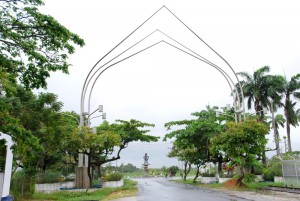Latest update December 22nd, 2024 4:10 AM
Latest News
- Each household in Guyana lost $1.7M in 2024 from Govt’s refusal to apply 65% windfall taxes on Exxon’s excess profits
- Citizens file Court action against Exxon’s 7th oil project
- Pope calls Gaza airstrikes ‘cruelty’ after Israeli minister’s criticism
- Brutus admits traveling to Lethem
- Toy gun bandit shot dead, accomplice escapes
Reflections on Brickdam, our ‘monumental’ and iconic First Street
May 31, 2015 Countryman, Features / Columnists
COUNTRYMAN – Stories about life, in and out of Guyana, from a Guyanese perspective
By Dennis Nichols
I love my imagination. On Monday last I sauntered nonchalantly up to the Independence Arch on Brickdam and watched the final touches being made to that monument as it was restored to burnished preeminence. I looked up, then down at the street I was standing on, and imagined that if it could speak, what an absorbing tale Brickdam would tell about its origin, its pride of place, and its iconic stature as the first street in Georgetown, constructed over 200 years ago.
Ancient Rome had its Appian Way, London has her Baker Street, and Georgetown has Brickdam. Approximately one mile long, stretching from the southern end of the Stabroek Market at its junction with the Demerara River, to Vlissengen Road, it had its genesis in the late eighteenth century during the period of French occupation.
Flanked by two canals and two stretches of primitive lots, it was then little more than a quaggy dam built up with canal excavation and burnt earth, and paved with red brick, thus giving it that singular name. It was reportedly covered over with asphalt sometime around 1820 in preparation for a visit by Prince Edward of Wales.
At the time, there were none of the landmark buildings and monuments which later graced this thoroughfare, but I presume it had some character even then. History tells us that it was built with the labour of our slave ancestors and later trod on by our indentured forebears, both under the overseeing eye of the European ‘masters’.
Brickdam would then have witnessed the first small ‘towns’ that sprung up there between 1785 and 1800, the offices and the wharf set up by American traders, where Yankee ships berthed and did business with the traders. That’s how America Street got its name.
Shortly thereafter, sometime between 1811 and 1818, one of Georgetown’s fairest and most distinctive structures, St. Andrews Kirk (Church) was constructed at the head of Brickdam (now just off that location) According to one source it is the oldest building in our capital city continually in use for religious purposes. It is said that the authorities of the day allowed slaves to worship there, and one can just imagine the entreaties that were made and the hymns of comfort and solace that were sung there by our afflicted ancestors.
Later, Brickdam would have felt herself blessed by the vista of palm trees lining and delineating her verges, stretching their graceful trunks skyward. Bared to the elements, she would have also endured the searing heat of noonday sun and the relentless deluge of tropical downpours that traced her contours and strengthened her resilience. She would have resounded with the tramp of bare feet and leather-soled boots on her skin, and the rumble of horse-drawn coaches and carriages toting the titled and the privileged.
By then she would have earned the honour of being the central avenue in the small but burgeoning town of Stabroek, named after the president of the Dutch West India Company which had established a trading post in the colony more than a century earlier. As Stabroek grew, other main streets were added, running north to south. These included Water Street which was built originally as a barrier against the Demerara River, High Street, and Camp Street, all of which had been completed by the turn of the century (1800).
Other streets of lesser prominence were then laid down, running roughly perpendicular to Brickdam, and crossing it, bearing the names of prominent government officials and members of society during those early years. They included Manget Place, Sendall Place, Boyle Place, Brummel Place, and Chalmers Place. Unlike these streets, Brickdam doesn’t condescend to any eponymous European title. Brickdam is Guyanese, ruggedly individualistic, and rooted in the robust spirit of early pioneering venture.
Over the years, mostly during the nineteenth century, a number of archetypal and significant buildings were constructed along the street or within its immediate boundaries. Among these were the aforementioned St. Andrew’s Church, Smiths Congregational Church, the Parliament Building, Stabroek Market, the Palms, (Alms House) St. Stanislaus College, the Brickdam Police Station, the Georgetown Magistrates’ Courts, the Ministry of Health building, the Ministry of Home Affairs building, the Chinese Association building, the Ministry of Education buildings, the YWCA building, the Brickdam Cathedral, and the Independence Arch. The street may also lay claim, through proximity, to the 1763 Monument which keeps guard over its eastern extremity.
Today, Brickdam’s older buildings are complemented by newer commercial structures including the Guyana Telephone and Telegraph Company building, (GT&T) the National Insurance Scheme (NIS) Head Office, with its conspicuous clay brick exterior, and the handsomely-designed Sleepin Hotel.
The architects of our independence must have had Brickdam in mind when the two Independence Arches were handed over to the government by the Demerara Bauxite Company (DEMBA) in 1966. It would have been eminently appropriate. From that year to about the early nineteen-eighties, the ‘Arch’ as we called it then, was a niche of relaxation, a trysting place for lovers, and, before it was desecrated, a place where Georgetowners were inclined to discuss the politics of the day and reflect on both the virtues and the vicissitudes of nation-building.
Nevertheless, I seem to recall, a degree of disenchantment began to creep in during the late seventies as city residents, and Guyanese in general, started to feel the pinch of the ban on certain commodities and the stress of queuing up daily for basic food items. Maybe some of us gradually became too drained physically and mentally to indulge in the kind of nationalistic sentiments represented by the ‘Arch’, and maybe subconsciously, we drifted away from the structure itself and what it stood for. Apathy slowly grew to neglect; vagrancy and filth filled that vacuum which nature abhors.
The ‘Arch’ became little more than a directional landmark; otherwise it was practically invisible. The one at Ruimveldt spanning the northern extremity of the East Bank corridor suffered a lesser fate – mere dismantling; at least it did not have to stand there and be ignored. For the past year and a half I passed the Brickdam monument two or three times a week, and even when I looked at it, I hardly saw it. The street itself must have winced at the ignominy of it all. That is, until two weeks ago.
Now, Brickdam feels clean again, beautiful and complete. Her buildings and her monuments are intact; her memory still keen. Her head nestles under the sentinel gaze of parliament, church and marketplace, her feet straddled protectively by a regal arch. Across the way, ‘Cuffy’ gazes in brooding silence and, like me, imagines what it must have felt like more than two centuries ago, when both of their stories began, one in Demerara, the other in Berbice, and intertwined themselves into the fabric of our history.
As I watched the clean-up activities of the past two weeks unfold, I could not help but experience the feeling, the nostalgia, of being part of history revisited. May 1966 to May 2015 is a long time but, as I said in an earlier piece, some things never change. I love my country as much as I did 49 years ago when, as a child, I stood in the Queen Elizabeth Park and gazed wonderingly as the Golden Arrowhead ascended into the midnight blue. For me, history repeated itself last Tuesday – on Brickdam – Guyana’s ‘monumental’ and iconic First Street.
Share this:
- Click to print (Opens in new window)
- Click to email a link to a friend (Opens in new window)
- Click to share on Facebook (Opens in new window)
- Click to share on WhatsApp (Opens in new window)
- Click to share on Twitter (Opens in new window)
- Click to share on Pinterest (Opens in new window)
- Click to share on Pocket (Opens in new window)
- Click to share on Tumblr (Opens in new window)
- Click to share on Reddit (Opens in new window)
- Click to share on LinkedIn (Opens in new window)
Related
Similar Articles

The Glenn Lall Show | December, 2nd, 2024
Follow on Tik Tok @Glennlall
THE BLUNT OF THE DAY

Sports
Dec 22, 2024
-Petra-KFC Goodwill Int’l Series concludes day at MoE Kaieteur Sports- The two main contenders in the KFC International Under-18 Secondary Schools Goodwill Football Series faced off yesterday ahead...Features/Columnists
Policy-making by neglect
Peeping Tom… Kaieteur News- The ease with which Bharrat Jagdeo, General Secretary of the People’s Progressive Party... more
Breaking the Chains of Poverty: A need for political will
By Sir Ronald Sanders Kaieteur News- The year 2024 has underscored a grim reality: poverty continues to be an unyielding... more
Publisher’s Note
Freedom of speech is our core value at Kaieteur News. If the letter/e-mail you sent was not published, and you believe that its contents were not libellous, let us know, please contact us by phone or email.
Feel free to send us your comments and/or criticisms.
Contact: 624-6456; 225-8452; 225-8458; 225-8463; 225-8465; 225-8473 or 225-8491.
Or by Email: [email protected] / [email protected]
Weekend Cartoon
















